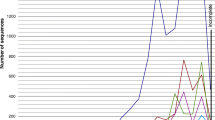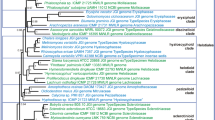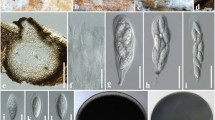Abstract
During the last two decades, the unprecedented development of molecular phylogenetic tools has propelled an opportunity to revisit the fungal kingdom under an evolutionary perspective. Mycology has been profoundly changed but a sustained effort to elucidate large sections of the astonishing fungal diversity is still needed. Here we fill this gap in the case of Lyophyllaceae, a species-rich and ecologically diversified family of mushrooms. Assembly and genealogical concordance multigene phylogenetic analysis of a large dataset that includes original, vouchered material from expert field mycologists reveal the phylogenetic topology of the family, from higher (generic) to lower (species) levels. A comparative analysis of the most widely used phylogenetic markers in Fungi indicates that the nuc rDNA region encompassing the internal transcribed spacers 1 and 2, along with the 5.8S rDNA (ITS) and portions of the genes for RNA polymerase II second largest subunit (RPB2) is the most performing combination to resolve the broadest range of taxa within Lyophyllaceae. Eleven distinct evolutionary lineages are identified, that display partial overlap with traditional genera as well as with the phylogenetic framework previously proposed for the family. Eighty phylogenetic species are delineated, which shed light on a large number of morphological concepts, including rare and poorly documented ones. Probing these novel phylogenetic species to the barcoding method of species limit delineation, indicates that the latter method fully resolves Lyophyllaceae species, except in one clade. This case study provides the first comprehensive phylogenetic overview of Lyophyllaceae, a necessary step towards a taxonomical, ecological and nomenclatural revision of this family of mushrooms. It also proposes a set of methodological guidelines that may be of relevance for future taxonomic works in other groups of Fungi.









Similar content being viewed by others
References
Abarenkov K, Henrik Nilsson R, Larsson KH, Alexander IJ, Eberhardt U, Erland S et al (2010) The UNITE database for molecular identification of fungi—recent updates and future perspectives. New Phytol 186(2):281–285
Alvarado P, Moreno G, Vizzini A, Consiglio G, Manjón JL, Setti L (2014) Atractosporocybe, Leucocybe and Rhizocybe: three new clitocyboid genera in the Tricholomatoid clade (Agaricales) with notes on Clitocybe and Lepista. Mycologia 106(5):13–369
Anisimova M, Gil M, Dufayard J-F, Dessimoz C, Gascuel O (2011) Survey of branch support methods demonstrates accuracy, power, and robustness of fast likelihood-based approximation schemes. Syst Biol 60(5):685–699
Baroni TJ, Franco-Molano AE, Lodge J, Linder DL, Horak E, Hofstetter V (2007) Arthromyces and Blastosporella, two new genera of conidia-producing lyophylloid agarics (Agaricales, Basidiomycota) from the neotropics. Mycol Res 111:572–580
Bon, M. (1992) Clé monographique des espèces galéro-naucorioïdes. Association d’écologie et de mycologie
Bon M (1994) Deux Lyophylloideae intéressantes et le genre Gerhardtia st. et nom. nov. Doc Mycol 24(93):65–68
Bon M (1999). Flore mycologique d’Europe 5. Collybio-marasmioïdes et ressemblants. Documents Mycologiques, Mémoire hors série n°5. Lille
Castresana J (2000) Selection of conserved blocks from multiple alignments for their use in phylogenetic analysis. Mol Biol Evol 17(4):540–552
Chevenet F, Brun C, Bañuls A-L, Jacq B, Christen R (2006) TreeDyn: towards dynamic graphics and annotations for analyses of trees. BMC Bioinform 7:439
Consiglio G, Contu M (2002) Il genere Lyophyllum P. Karst. emend. Kühner, in Italia. Rivista di Micologia 45:99–181
Contu M, Consiglio G (2005) “2004” Il genere Gerhardtia (Lyophyllaceae) in Europa, con osservazioni sulle rimanenti specie conosciute. Micologia e Vegetazione Mediterranea 19(2): 151–162
Cooper JA (2014) New species and combinations of some New Zealand agarics belonging to Clitopilus, Lyophyllum, Gerhardtia, Clitocybe, Hydnangium, Mycena, Rhodocollybia and Gerronema. Mycosphere 5(2):263–288
Courtecuisse R, Duhem B (2012) Champignons de France et d’Europe. 2e édition. Delachaux & Niestlé, Lausanne
Dereeper A, Guignon V, Blanc G, Audic S, Buffet S, Chevenet F et al (2008) Phylogeny.fr: robust phylogenetic analysis for the non-specialist. Nucleic Acids Res 36(2):465–469
Donk MA (1962) The generic names proposed for Agaricaceae. Beihefte zur Nova Hedwigia 5:320
Du X-H, Zhao Q, Yang ZL, Hansen K, Taşkın H, Büyükalaca S et al (2012) How well do ITS rDNA sequences differentiate species of true morels (Morchella)? Mycologia 104:1351–1368
Edgar RC (2004) MUSCLE: multiple sequence alignment with high accuracy and high throughput. Nucleic Acids Res 32(5):1792–1797
Frøslev TG, Jeppesen TS, Laessøe T, Kjøller R (2007) Molecular phylogenetics and delimitation of species in Cortinarius section Calochroi (Basidiomycota, Agaricales) in Europe. Mol Phylogenet Evol 44(1):217–227
Gardes M, Bruns TD (1993) ITS primers with enhanced specificity for basidiomycetes—application to the identification of mycorrhizae and rusts. Mol Ecol 2:113–118
Giraud T, Refrégier G, Le Gac M, de Vienne DM, Hood ME (2008) Fungal Genet Biol 45(6):791–802
Guindon S, Dufayard J-F, Lefort V, Anisimova M, Hordijk W et al (2010) New algorithms and methods to estimate maximum likelihood phylogenies: assessing the performance of PhyML 3.0. Syst Biol 59(3):307–321
Harder CB, Laessøe T, Frøslev TG, Ekelund F, Rosendhal S, Kjøller R (2013) A three-gene phylogeny of the Mycena pura complex reveals 11 phylogenetic species and shows ITS to be unreliable for species identification. Fungal Biol 117:764–775
Hibbett DS (2007) After the gold rush, or before the flood? Evolutionary morphology of mushroom-forming fungi (Agaricomycetes) in the early 21st century. Mycol Res 111:1001–1018
Hofstetter V, Clémençon H, Vilgalys R, Moncalvo JM (2002) Phylogenetic analyses of the Lyophylleae (Agaricales, Basidiomycota) based on nuclear and mitochondrial rDNA sequences. Mycol Res 106(9):1043–1059
Hofstetter V, Redhead SA, Kauff F, Moncalvo J-M, Matheny PB, Vilgalys R (2014) Taxonomic revision and examination of ecological transitions of the Lyophyllaceae (Basidiomycota, Agaricales) based on a multigene phylogeny. Cryptogam Mycol 35(4):399–425
Holec J, Kolařík M (2013) Ossicaulis lachnopus (Agaricales, Lyophyllaceae), a species similar to O. lignatilis, is verified by morphological and molecular methods. Mycol Prog 12(3):589–597
James TY, Kauff F, Schoch CL, Matheny PB, Hofstetter V, Cox CJ et al (2006) Reconstructing the early evolution of Fungi using a six-gene phylogeny. Nature 443:818–822
Jargeat P, Martos F, Carriconde F, Gryta H, Moreau P-A, Gardes M (2010) Phylogenetic species delimitation in ectomycorrhizal fungi and implications for barcoding: the case of the Tricholoma scalpturatum complex (Basidiomycota). Mol Ecol 19:5216–5230
Jülich W (1982) Lyophyllaceae. Bibl Mycol 85:378
Karsten PA (1881) Hymenomycetes Fennici. Acta Societatis pro Fauna et Flora Fennica 2(1):40
Kiss L (2012) Limits of nuclear ribosomal DNA internal transcribed spacer (ITS) sequences as species barcodes for Fungi. Proc Natl Acad Sci USA 109(27):E1811
Knudsen H, Vesterholt J, (eds) (2012) Funga Nordica. Nordsvamp, Copenhagen
Kühner R (1938) Utilisation du carmin acétique dans la classification des Agarics leucosporés. Bulletin Mensuel de la Société Linnéenne de Lyon 7:204–211
Kühner R (1980) Les Hyménomycètes agaricoides. Bulletin Mensuel de la Société Linnéenne de Lyon 49:1–1027
Kühner R, Romagnesi H (1953) Flore analytique des champignons supérieurs (agarics, bolets, chanterelles). Masson & Cie, Paris
Larsson E, Sundberg H (2011) Lyophyllum shimeji, a species associated with lichen pine forest in northern Fennoscandia. Mycoscience 52(5):289–295
Liu YJ, Whelen S, Hall BD (1999) Phylogenetic relationships among ascomycetes: evidence from an RNA polymerase II subunit. Mol Biol Evol 16:1799–1808
Matheny PB (2005) Improving phylogenetic inference of mushrooms with RPB1 and RPB2 nucleotide sequences (Inocybe, Agaricales). Mol Phylogenet Evol 35:1–20
Matheny PB, Curtis JM, Hofstetter V, Aime MC, Moncalvo JM, Ge ZW (2006) Major clades of Agaricales: a multilocus phylogenetic overview. Mycologia 98(6):982–995
Moreau P-A, Vila J, Aime MC, Antonin V, Horak E, Pérez-Butron JL, Richard F, Urban A, Welti S, Vizzini A (2015) Cibaomyces and Cyptotrama, two new genera for Europe, and an emendation of Rhizomarasmius (Basidiomycota, Physalacriaceae). Mycol Prog (in press)
Neville P, Poumarat S (1997) Premiere récolte française de Tephrocybe gibberosa et sa position par rapport aux Tephrocybe carbonicoles. Bollettino del Gruppo Micologico Bresadola 40:347–366
Norvell LL (2010) Report of the nomenclature committee for fungi: 15. Taxon 59(1):291–293
O’Donnell K, Rooney AP, Mills GL, Kuo M, Weber NS, Rehner SA (2011) Phylogeny and historical biogeography of true morels (Morchella) reveals an early Cretaceous origin and high continental endemism and provincialism in the Holarctic. Fungal Genet Biol 48:252–265
Osmundson TW, Robert VA, Schoch CL, Baker LJ, Smith A, Robich G et al (2013) Filling gaps in biodiversity knowledge for macrofungi: contributions and assessment of an herbarium collection DNA barcode sequencing project. PLoS One 8(4):e62419
R Core Team (2014) R: A language and environment for statistical computing. R foundation for statistical computing, Vienna, Austria. http://www.R-project.org/
Redhead SA (1981) Parasitism of bryophytes by agarics. Can J Bot 59:63–67
Redhead SA (2014) Nomenclatural novelties. Index Fungorum 202:1
Redhead SA, Hofstetter V, Clémençon H, Moncalvo J-M (2006) 1742) Proposal to conserve the name Lyophyllum with a conserved type (Basidiomycota. Taxon 55(4):1034–1036
Ronquist F, Huelsenbeck JP (2003) MrBayes 3: bayesian phylogenetic inference under mixed models. Bioinformatics 19(12):1572–1574
Schoch CL, Seifert KA, Huhndorf S, Robert V, Spouge JL, Levesque CA, Chen W et al (2012) Nuclear ribosomal internal transcribed spacer (ITS) region as a universal DNA barcode marker for Fungi. Proc Natl Acad Sci USA 109(16):6241–6246
Seifert KA (2009) Progress towards DNA barcoding of fungi. Mol Ecol Res 9:83–89
Singer R (1986) The agaricales in modern taxonomy. Koeltz Scientific Books, Koenigstein, p 981p
Talavera G, Castresana J (2007) Improvement of phylogenies after removing divergent and ambiguously aligned blocks from protein sequence alignments. Syst Biol 56(4):564–577
Taylor JW, Jacobson DJ, Kroken S, Kasuga T, Geiser DM, Hibbett DS, Fisher MC (2000) Phylogenetic species recognition and species concepts in fungi. Fungal Genet Biol 31(1):21–32
Vesterholt J, Ludwig E (2012) Lyophyllum. In: Knudsen H, Vesterholt J, (eds): 583
Wang X-Q, Zhou D-Q, Zhao Y-C, Zhang X-L, Li L, Li S-H (2013) Lyophyllum rhombisporum sp. nov. from China. Mycotaxon 123(5):473–477
Acknowledgments
This work is dedicated to the memory of the French mycologist Marcel Bon, who contributed major advances in our current knowledge of the biodiversity of Lyophyllaceae, and recently passed away. This project was supported by the grant “Diversité des champignons mycorhiziens des plantes” (DivMyc, to M.-A. Selosse) from the network Bibliothèque Du Vivant (BDV) funded by the CNRS, the Museum National d’Histoire Naturelle, the INRA and the CEA (Centre National de Séquençage). DNA extracts were generated at the Service of Genetic Markers of UMR-CEFE 5175. We are grateful to M.-P. Dubois, F. Kjellberg and J.-Y Rasplus for their support from the sequencing programs. We thank C. Hannoire, R. Courtecuisse and Y. Deneyer for providing precious material to the present study. J.-M. B. is personally grateful to A. Taudière for his introduction to the R software.
Author information
Authors and Affiliations
Corresponding author
Electronic supplementary material
Below is the link to the electronic supplementary material.
Rights and permissions
About this article
Cite this article
Bellanger, J.M., Moreau, P.A., Corriol, G. et al. Plunging hands into the mushroom jar: a phylogenetic framework for Lyophyllaceae (Agaricales, Basidiomycota). Genetica 143, 169–194 (2015). https://doi.org/10.1007/s10709-015-9823-8
Received:
Accepted:
Published:
Issue Date:
DOI: https://doi.org/10.1007/s10709-015-9823-8




